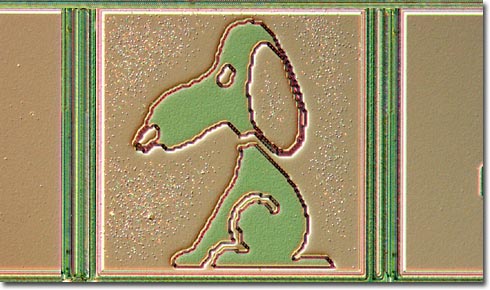Snoopy
|
In October 1950, cartoon illustrator Charles Schultz added the character Snoopy, a young beagle pup, to his comic strip Peanuts. Serving as lead personality Charlie Brown's independently-minded dog, Snoopy has played an integral role in the broad success of the cartoon and has a reserved a place in hearts of millions of fans. The silicon version of Snoopy illustrated above was discovered by Richard Piotter of New Ulm, Minnesota, who also loaned the 4-inch wafer (made by a 1980s-era semiconductor company named Trilogy) from which the image is derived. Snoopy grew from a puppy to adult dog as a vast generation of baby boomers in the United States matured and started their own families. Although he never speaks in the strip, Snoopy readily communicates by actions, expressions, and thoughts encapsulated by bubbles viewed by the readers. After 1955, when Snoopy first found his way onto Linus' sacred blanket, he evolved from part of the ensemble into a starring role. Schultz created several personae for his canine star, including a World War I flying ace, the big "man" on campus Joe Cool, and a mystery writer, often plagued by writer's block and surrounded by crumpled rewrites. Acting in the role of a vulture, Snoopy is regularly seen on the funny pages and in cartoon television specials leering from his high roost, the versatile doghouse. From this perch, he guards his food bowl and scans the yard for the elusive and slightly dangerous cat from next door. Through his creative genius, Charles Schultz was able to convey the importance of imagination to his audience with the antics of his cartoon beagle. In this age of computer games, virtual reality, and digital video discs, Snoopy and his little feathered friend Woodstock repeatedly remind us that creativity and fun don't require too many expensive props or digital hi-tech gear. An old manual typewriter, hockey skates, or a birdbath can transform Snoopy's rather mundane existence into an exciting imaginary world full of real-life scenarios. A scarf, a hat, or a pair of aviator sunglasses is often all it takes to sweep us along on a whirlwind adventure to North Africa or back to World War I-era France. Fearless, imaginative, and independent, Snoopy leaves no doubts as to who holds the superior intelligence in this comic strip. According to creator Charles Schultz, it is definitely not man's, but rather a dog's world. View this silicon artwork under brightfield and darkfield illumination. |
© 1995-2025 by Michael W. Davidson and The Florida State University. All Rights Reserved. No images, graphics, software, scripts, or applets may be reproduced or used in any manner without permission from the copyright holders. Use of this website means you agree to all of the Legal Terms and Conditions set forth by the owners.
This website is maintained by our
|
